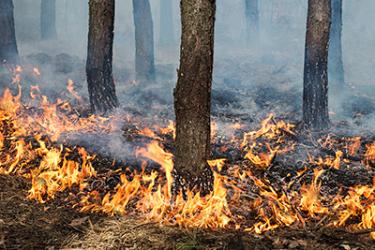What To Do on Burn Day
As burn day draws near, keep an eye on the weather. If you see unstable weather, strong winds or low humidity in the forecast, reschedule the burn. Don’t take chances with the weather—the wrong conditions can make for a dangerous fire, or one that doesn’t meet your objectives.
But if the weather is favorable, your plan is set and your equipment and crew are ready, then you can start your burn. Here’s a basic plan for the day that will keep things running smoothly and safely:
- Start by assembling your crew and going over the burn plan. Make sure everyone understands his or her role in it. Check your equipment to be certain that everything works.
- Set a small test fire in the downwind corner of the burn site to see how the fire behaves and how your crew responds. Handling a small fire will also help everyone get a little more comfortable with the burn process.
- With the test fire done, start the actual burn in the downwind corner of the burn site. This first part of your burn should be the “backfire,” a fire that burns slowly as it moves against the wind. Then ignite the flank fires, which are parallel to the wind and will burn more quickly. The backfire and flank fires will form an additional firebreak of burned ground, keeping the burn area’s perimeter safe as you light the headfires, which are strips of fast-moving fire that do much of the burning. Keep the strips small and manageable; a half-mile-long strip is too long to be safe.
- Stay vigilant and go slow. Don’t set more fire than your crew can easily control. Be alert to any changes in the wind, the fire’s behavior, or the locations and abilities of your crew members. Have at least one crew member check back along to fireline to see if fires have reignited or are creeping across your firebreaks.
- Once your burn is done, “mop-up” begins. Make certain the fire is completely out, because even the smallest smoldering ember can cause a wildfire. Drench the area with water or water mixed with detergent, and check the area again one or two days later to make sure nothing has reignited. Don’t bury hot coals or embers, because they can continue to burn underground and eventually cause a wildfire.
- When the mop-up is complete and you’re certain the fire is out, contact your neighbors and any other agencies in your plan to let them know.
- Evaluate your work. Did the burn meet your goals? Were there areas where the fire did not behave as expected? Were your firebreaks, safety measures and equipment effective? How did your crew do? Taking stock of your controlled burn will show you where you succeeded, and what changes you can make the next time around to have an even safer and more successful operation.
Because of the risks and extensive preparation involved, many landowners get help planning and conducting their controlled fires. Some local forestry or natural resources agencies even have firefighting equipment you can borrow for your burn. You don’t have to go it alone.
How can I get more tips?
It’s simple! Enter your email below.

